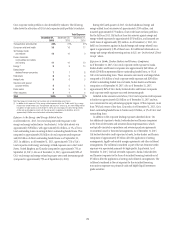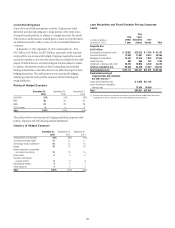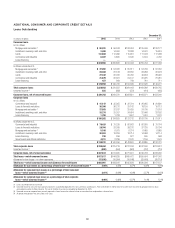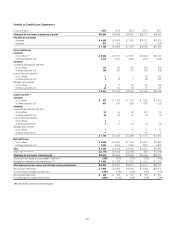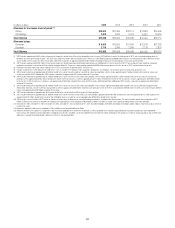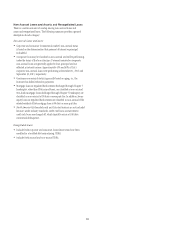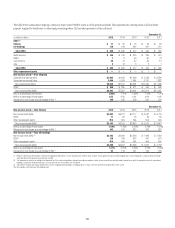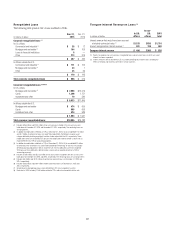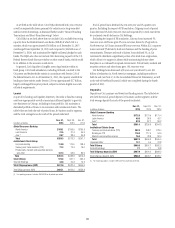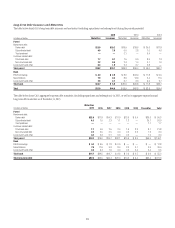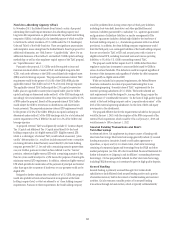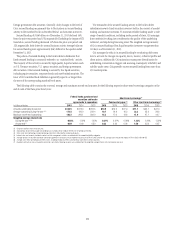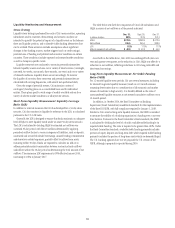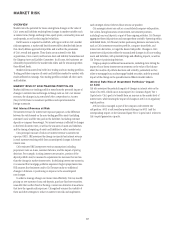Citibank 2015 Annual Report Download - page 106
Download and view the complete annual report
Please find page 106 of the 2015 Citibank annual report below. You can navigate through the pages in the report by either clicking on the pages listed below, or by using the keyword search tool below to find specific information within the annual report.
88
LIQUIDITY RISK
OVERVIEW
Adequate and diverse sources of funding and liquidity are essential to Citi’s
businesses. Funding and liquidity risks arise from several factors, many of
which are mostly or entirely outside Citi’s control, such as disruptions in the
financial markets, changes in key funding sources, credit spreads, changes
in Citi’s credit ratings and political and economic conditions in certain
countries. For additional information, see “Risk Factors” above.
Citi’s funding and liquidity objectives are aimed at (i) funding its existing
asset base; (ii) growing its core businesses in Citicorp; (iii) maintaining
sufficient liquidity, structured appropriately, so that Citi can operate under
a variety of adverse circumstances, including potential firm-specific and/or
market liquidity events in varying durations and severity; and (iv) satisfying
regulatory requirements. Citigroup’s primary liquidity objectives are
established by entity, and in aggregate, across two major categories:
• Citibank; and
• the non-bank and other, which includes the parent holding company
(Citigroup), Citi’s broker-dealer subsidiaries and other non-bank
subsidiaries that are consolidated into Citigroup, as well as Banamex and
Citibank (Switzerland) AG.
At an aggregate level, Citigroup’s goal is to maintain sufficient funding
in amount and tenor to fully fund customer assets and to provide an
appropriate amount of cash and high-quality liquid assets (as discussed
further below), even in times of stress. The liquidity risk management
framework provides that certain entities be self-sufficient or net providers
of liquidity, including in conditions established under their designated
stress tests.
Citi’s primary sources of funding include (i) deposits via Citi’s bank
subsidiaries, which are Citi’s most stable and lowest cost source of long-
term funding, (ii) long-term debt (primarily senior and subordinated
debt) primarily issued at the parent and certain bank subsidiaries, and
(iii) stockholders’ equity. These sources may be supplemented by short-term
borrowings, primarily in the form of secured funding transactions.
As referenced above, Citigroup works to ensure that the structural tenor
of these funding sources is sufficiently long in relation to the tenor of its
asset base. The goal of Citi’s asset/liability management is to ensure that
there is excess tenor in the liability structure relative to the liquidity profile of
the assets. This reduces the risk that liabilities will become due before asset
maturities or monetizations through sale, and in turn generates liquidity.
This liquidity is held primarily in the form of high-quality liquid assets
(HQLA), as set forth in the table below.
Citi’s Treasurer has overall responsibility for management of Citi’s HQLA.
Citi’s liquidity is managed via a centralized treasury model by Corporate
Treasury, in conjunction with regional and in-country treasurers. Pursuant
to this approach, Citi’s HQLA is managed with emphasis on asset-liability
management and entity-level liquidity adequacy throughout Citi.
Citi’s Chief Risk Officer is responsible for the overall risk profile of Citi’s
HQLA. The Chief Risk Officer and Citi’s CFO co-chair Citi’s Asset Liability
Management Committee (ALCO), which includes Citi’s Treasurer and
other senior executives. ALCO sets the strategy of the liquidity portfolio and
monitors its performance. Significant changes to portfolio asset allocations
need to be approved by ALCO.
High-Quality Liquid Assets (HQLA)
Citibank Non-Bank and Other (1) Total
In billions of dollars
Dec. 31,
2015
Sept. 30,
2015
Dec. 31,
2014
Dec. 31,
2015
Sept. 30,
2015
Dec. 31,
2014
Dec. 31,
2015
Sept. 30,
2015
Dec. 31,
2014
Available cash $ 52.4 $ 68.9 $ 65.2 $16.9 $21.5 $37.5 $ 69.3 $ 90.4 $102.7
U.S. sovereign 110.1 119.6 112.4 32.4 22.4 27.1 142.4 142.0 139.5
U.S. agency/agency MBS 63.8 60.1 56.4 1.0 1.0 0.8 64.9 61.1 57.1
Foreign government debt(2) 84.8 87.6 97.3 14.9 15.5 12.8 99.7 103.0 110.2
Other investment grade 1.0 0.8 1.8 1.2 1.5 1.4 2.2 2.4 3.1
Total $312.1 $337.0 $333.1 $66.4 $61.9 $79.6 $378.5 $398.9 $412.6
Note: Amounts set forth in the table above are as of period end and may increase or decrease intra-period in the ordinary course of business. For securities, the amounts represent the liquidity value that potentially could be
realized, and thus exclude any securities that are encumbered, as well as the haircuts that would be required for securities financing transactions.
(1) “Non-Bank and Other” includes the parent holding company (Citigroup), Citi’s broker-dealer subsidiaries and other non-bank subsidiaries that are consolidated into Citigroup as well as Banamex and Citibank
(Switzerland) AG. Banamex and Citibank (Switzerland) AG account for approximately $6 billion of the “Non-Bank and Other” HQLA balance as of December 31, 2015.
(2) Foreign government debt includes securities issued or guaranteed by foreign sovereigns, agencies and multilateral development banks. Foreign government debt securities are held largely to support local liquidity
requirements and Citi’s local franchises, and principally include government bonds from Hong Kong, India, Korea and Mexico.


